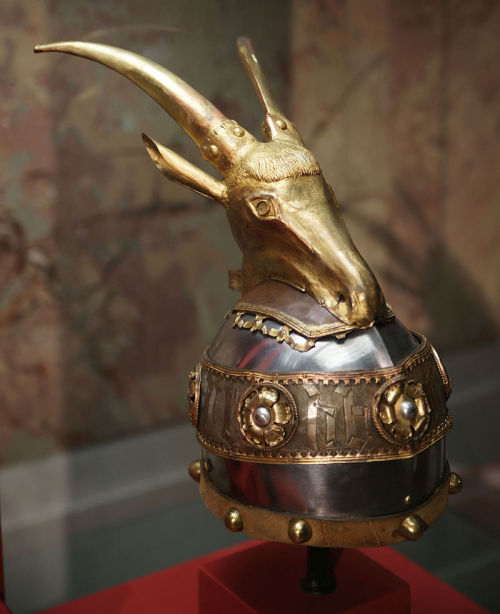The helmet of SkanderbegSkanderbeg (Albanian: Gjergj Kastrioti ) was a prominent figure in the histo
The helmet of SkanderbegSkanderbeg (Albanian: Gjergj Kastrioti ) was a prominent figure in the history of Albania. His weapons have been subjects of mythical adoration. According to legends, his sword was so heavy that only his arm could wield it. It was also said to be so sharp that it could slice a man vertically from head to waist with little effort and cut a huge boulder in half with a single blow.Of all of Skanderbeg’s belongings, but four objects remain: two swords, a helmet, and a prayer book. Currently the weapons (helmet and swords) are on display in the Collection of Arms and Armour at the Neue Burg (affiliated with the Kunsthistorisches Museum) in Vienna after having passed through the hands of countless noblemen since the 15th century when they were first brought over to Italy from Albania by Skanderbeg’s wife, Donika Kastrioti. The prayer book is archived at the Shelley Publishing House in Chelsea, London in England.Skanderbeg’s helmet is made of white metal, adorned with a strip dressed in gold. On its top lies the head of a horned goat made of bronze, also dressed in gold. The bottom part bears a copper strip adorned with a monogram separated by rosettes * IN * PE * RA * TO * RE * BT *, which means: Jhezus Nazarenus * Principi Emathie * Regi Albaniae * Terrori Osmanorum * Regi Epirotarum * Benedictat Te (Jesus Nazarene Blesses Thee [Skanderbeg], Prince of Emathia (the central region of Albania called Mat), King of Albania, Terror of the Ottomans, King of Epirus). It is thought that the copper strip with the monogram is the work of the descendants of Skanderbeg and was placed there by them, as Skanderbeg never held any other title but “Lord of Albania” (Latin: Dominus Albaniae). According to a report by historian Shefqet Pllana, Sami Frasheri in his Kamus-al-Alam maintains that the wording “Dhu lKarnejn” (owner of the two horns) was an appellative attributed to Alexander the Great of Macedon, the very name which Skanderbeg bore in the Islamic form. At the request of the pre-WWII Albanian government, an identical copy of the helmet of Skanderbeg lies now in the National Museum of Tirana, Albania. The copy was manufactured by an Austrian master in 1937.The helmet is depicted on the reverse of the Albanian 5000 lekë banknote, issued since 1996. -- source link
#fashion#helmet#albania#albanian fashion#medieval#medieval fashion#crowns#balkans#balkans fashion

